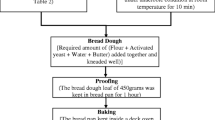Abstract
This work proposed to study the effects of the addition of whole chia flour (WCF) on the technological, nutritional and sensory qualities of bread. Different WCF contents (0 and 20 %) and vital gluten (VG) (0 and 4 %) were added to bread according to a 22 central composite rotational design. WCF decreased the specific volume, lightness and hue angle of the bread loaves, but did not affect the chroma values. WCF and VG contributed to maintenance of the moisture content of the loaves during the storage period. The increased firmness found with the addition of high levels of WCF (more than 10 %) was countered by larger amounts of VG (more than 2 %). The optimum loaf (10 % WCF and 2 % VG) showed 26 % more lipids, 19 % more protein and 11 % more ash than the standard loaf (0 % WCF and 0 % VG). A better lipid profile was also found (higher omega-3 fatty acid content and a better omega-6/omega-3 ratio). Both breads were positively rated in the sensory profile analysis.


Similar content being viewed by others
References
AACC - American Association of Cereal Chemists (2010) International approved methods of analysis. AACC International, St Paul. http://methods.aaccnet.org/. Accessed 01 November 2011
AENOR - Asociación española de normalización y certificación (1991) Catálogo de normas UNE. Norma UNE 55037–73. AENOR, Madrid
Aguilar MJR, de Palomo P, Bressani R (2004) Development of bakery products for greater adult consumption based on wheat and rice flour. Arch Latinoam Nutr 54:314–321
AOAC - Association of Official Analytical Chemists (2000) Official methods of analysis of association of official analytical chemists. AOAC International, Gaithersburg
Brites C, Trigo MJ, Santos C, Collar C, Rosell CM (2008) Maize-based gluten-free bread: influence of processing parameters on sensory and instrumental quality. Food Bioprocess Technol 3:707–715. doi:10.1007/s11947-008-0108-4
Collado-Fernández M (2003) Breadmaking processes. In: Caballero B (ed) Encyclopedia of food sciences and nutrition. Academic, San Diego, pp 627–634
El-Dash AA, Germani R (1994) Tecnologia de farinha mistas: uso de farinhas mistas na produção de biscoitos. Embrapa, Brasília
Ixtaina VY, Nolasco SM, Tomás MC (2008) Physical properties of chia (Salvia hispanica L.) seeds. Ind Crops Prod 28:286–293. doi:10.1016/j.indcrop.2008.03.009
Ixtaina VY, Veja A, Nolasco SM, Tomás MC, Miquel Gimeno M, Bárzana E, Tecante A (2010) Supercritical carbon dioxide extraction of oil from Mexican chia seed (Salvia hispanica L.): characterization and process optimization. J Supercrit Fluids 55:192–199. doi:10.1016/j.supflu.2010.06.003
Jiménez FEG, Beltrán-Orozco MC, Martínez VMG (2010) The antioxidant capacity and phenolic content of chía’s (Salvia hispanica L.) integral seed and oil. J Biotechnol 150:S315–S315. doi:10.1016/j.jbiotec.2010.09.295
Lai H-M, Lin T-C (2006) Bakery products. In: Hui YH (ed) Handbook of food science, technology and engineering. CRC Press, Boca Raton, pp 148.1–148.51
Luna Pizarro P, Almeida EL, Sammán NC, Chang YK (2013) Evaluation of whole chia (Salvia hispanica L.) flour and hydrogenated vegetable fat in pound cake. LWT Food Sci Technol 54:73–79. doi:10.1016/j.lwt.2013.04.017
Olivos-Lugo BL, Valdivia-Lopez MA, Tecante A (2010) Thermal and physicochemical properties and nutritional value of the protein fraction of mexican chia seed (Salvia hispanica L.). Food Sci Technol Int 16:89–96. doi:10.1177/1082013209353087
Peiretti PG, Gai F (2009) Fatty acid and nutritive quality of chia (Salvia hispanica L.) seeds and plant during growth. Anim Feed Sci Technol 148:267–275. doi:10.1016/j.anifeedsci.2008.04.006
Reyes-Caudillo E, Tecante A, Valdivia-Lopez MA (2008) Dietary fibre content and antioxidant activity of phenolic compounds present in Mexican chia (Salvia hispanica L.) seeds. Food Chem 107:656–663. doi:10.1016/j.foodchem.2007.08.062
Rodrigues MI, Iemma AF (2005) Planejamento de experimentos e otimização de processos: uma estratégia seqüencial de planejamentos. Casa do Pão, Campinas
Sabanis D, Tzia C (2009) Effect of rice, corn and soy flour addition on characteristics of bread produced from different wheat cultivars. Food Bioprocess Technol 2:68–79. doi:10.1007/s11947-007-0037-7
Sahagun B (1982) Historia general de las cosas de Nueva España. Fomento Cultural Banamex, Mexico
Sciarini L, Ribotta P, León A, Perez G (2008) Influence of gluten-free flours and their mixtures on batter properties and bread quality. Food Bioprocess Technol 3:577–585. doi:10.1007/s11947-008-0098-2
Simopoulos AP, Cleland LG (2003) Omega-6/omega-3 essential fatty acid ratio: the scientific evidence. World Rev Nutr Diet 92: I-XIII
Stone H, Sidel JL (1993) Sensory evaluation practices. Academic, San Diego
Vasconcelos A, Pontes D, Garrutu D, Silva A (2006) Processamento e aceitabilidade de pães de forma a partir de ingredientes funcionais: farinha de soja e fibra alimentar. Braz J Food Nutr 17:43–49
Acknowledgments
The authors would like to thank the CAPES-SPU (Coordination for the Improvement of Higher Education Personnel) via CAPG-BA for funding the research.
Author information
Authors and Affiliations
Corresponding author
Rights and permissions
About this article
Cite this article
Luna Pizarro, P., Almeida, E.L., Coelho, A.S. et al. Functional bread with n-3 alpha linolenic acid from whole chia (Salvia hispanica L.) flour. J Food Sci Technol 52, 4475–4482 (2015). https://doi.org/10.1007/s13197-014-1477-5
Revised:
Accepted:
Published:
Issue Date:
DOI: https://doi.org/10.1007/s13197-014-1477-5




